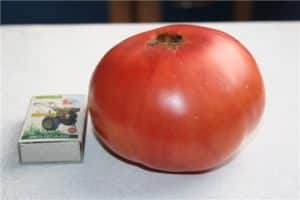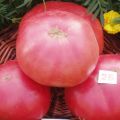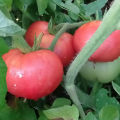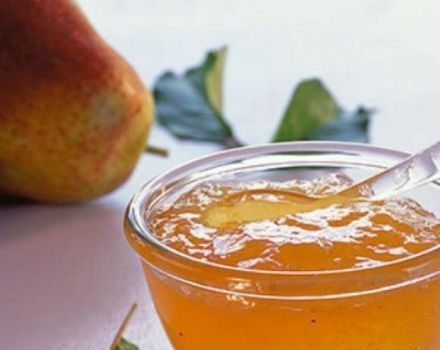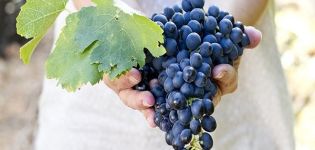Characteristics and description of the Pink Flamingo tomato variety, its yield
Tomato Pink Flamingo differs from other varieties in its very sweet taste and large fruits.
Description of tomato Pink Flamingo is an indeterminate variety that grows even when the fruit is ripe. Because of this, the bushes can reach a height of 1.5 - 2 m. In addition to indeterminate varieties, there are determinant varieties, which are characterized by the fact that when the fruits are set, the stem stops growing. The bush of the determinant variety is usually undersized: it is easier to care for it, it does not have to be tied up.
What the bushes and fruits of the variety look like
Description of the variety of tomatoes: the bushes of Pink Flamingo have carved leaves, a fragile stem. This is a mid-season variety, the fruits ripen 110 days after the emergence of sprouts, but if favorable conditions have been created for the growth of tomatoes, then they can ripen in 90 days. Seedlings are planted both in the greenhouse and on the site.
Characteristics of vegetables: at first, larger fruits are formed, then they become smaller, that is, the first tomatoes weigh up to 450 g, and then those with a mass of 100-200 g appear.
Description of fruits: in shape they resemble a plum, have an average density. Ripe fruits are light or dark pink. Color depending on the conditions in which they were grown. It tastes very sweet and juicy - much sweeter than other varieties... Although there is an equally sweet variety called Vintage Wine, the fruits of which, when ripe, become striped, red in color with yellowish stripes.
Pink Flamingo fruits differ from other varieties in that they do not have a green spot near the stem. They have the most delicate pulp and few seeds. Tomatoes are eaten fresh, put in salads, canned food. Due to the soft pink color of the juice, the paste is made quite rarely.
Advantages and disadvantages
The Pink Flamingo has many benefits:
- It has large fruits.
- The yield is average. You can remove 4 - 7 kg of fruits from 1 m², and with careful care - up to 10 kg.
- It is immune to a variety of diseases, bacteria and fungi. But do not neglect preventive measures against diseases and pests.
- Pink Flamingo tolerates drought or increased severity well, does not get sick or wither. Because of this, seedlings can be planted in different regions, even in areas of risky farming.
- Fruits can be harvested unripe - they ripen perfectly in a warm room.
- When stored properly, vegetables can last up to 2 months.
- It is good to transport over long distances, since the skin of the fruit is strong and dense.
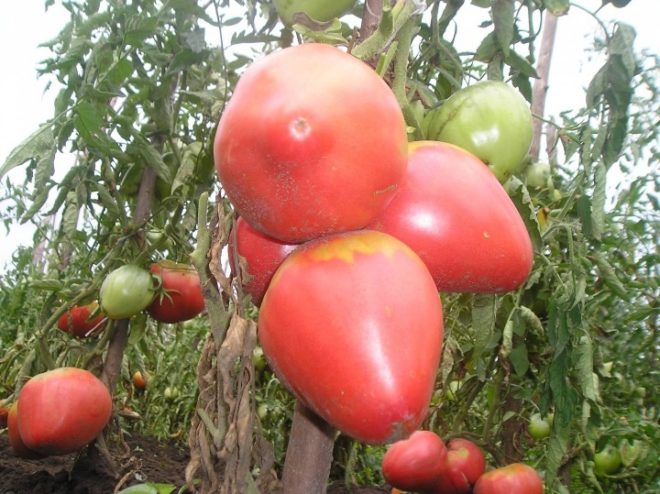
But still, the variety has disadvantages:
- Not suitable for industrial cultivation, as it gives medium yields.
- The seeds have a high germination rate for only 6 years, which is quite small compared to other varieties.
- The variety still needs to be carefully cared for.
- Fruits crack if stored for too long.
Care advice
If you have received a small harvest of tomatoes, then the main reason for this is improper care of the bushes, since certain varieties of tomatoes need not only be planted and watered. It is required to carefully look after tomatoes, observe all agrotechnical techniques, create the best conditions for the crop in order to get an excellent harvest as a result.
Requirements for soil and seedling planting site
The Pink Flamingo prefers fertile soil with a lot of fertilization. Find a sunny spot. Plant the seedlings in the place where legumes or cabbage previously grew in the soil.
In order to grow seedlings in the future, in the fall, scatter 4 kg of humus or compost on 1 m² of the plot, dig up to the depth of a shovel. Remove all weeds and roots. In the spring, scatter 80 g of superphosphate and 20 g of potassium chloride on 1 m², and re-dig the earth.
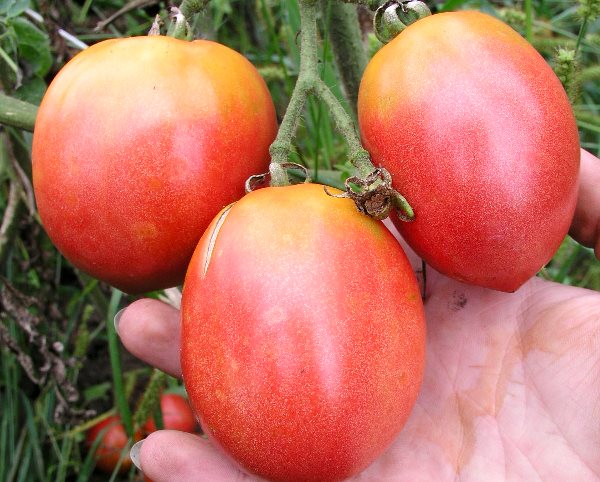
Experienced gardeners advise planting tomatoes in the area where green manure had grown before: white mustard, phacelia, oil radish, lupine, vetch, alfalfa.
Try sowing these crops in early spring before placing the seedlings in the ground. Then plant next to green manure seedlings of tomatoes... Mow the green manure from time to time and add mulch under the bushes. But each type of green manure can be planted in one place for no more than 1 - 2 years, and then sow another type.
Sowing seeds
Before sowing, harden the seeds and process by placing them in a solution of potassium permanganate so that the grown bushes do not start to hurt. Then rinse the seeds thoroughly in plain clean water.
Sow seeds in early April or late March. You cannot sow them later than April 10th. Spread the seeds over the surface of the soil and dust a little with earth. After pouring, cover the boxes with polyethylene film. Place in a warm place where the air temperature is kept at + 25 ° C. When you see the first shoots, remove the film. Then you can lower the air temperature a little. Water the seedlings regularly.
After the emergence of shoots with 2 leaves, the seedlings dive. Any containers are suitable for seedlings: plastic cups, plastic bottles with the top cut off, boxes. But you need to make holes in them for drainage.
Transplanting seedlings to the site
When the culture is 2 months old, then it is transplanted to the site. To plant this variety, holes are pulled out, observing an indent between them of 40 cm, and a distance of 70 cm is made between the rows. Seedlings are planted in the holes.
Further care of seedlings
In the open ground or in a greenhouse, seedlings need to be fertilized 2 - 3 times per season. Complex mineral fertilizers and organic matter are taken as top dressing.
The first time is fed 2 weeks after transplanting. It is better to use mullein or chicken manure solution. Pour 50 - 60 g of ammophos (or superphosphate) into a bucket of organic solution, another 250 - 300 g of wood ash. A bucket of fertilizer is enough for 15 - 20 bushes. Fertilize after abundant watering, and water the plants again after fertilizing.
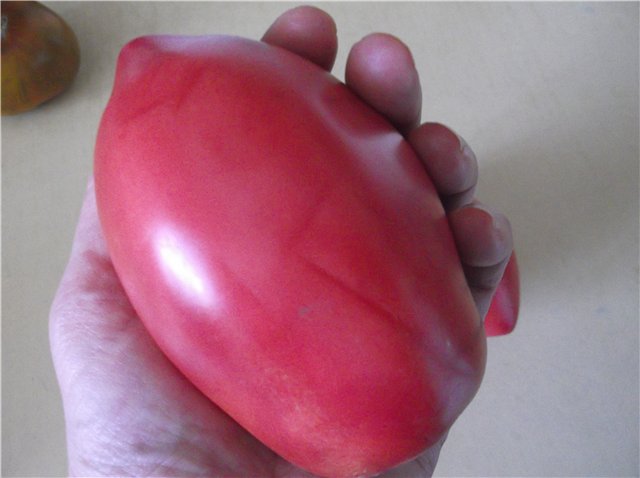
Water the bushes with warm, settled water. Do this at a time when the sun has not yet risen, or has already set.
Since this is an indeterminate variety, tie up the bushes and constantly cut off the stepsons. When the bush forms 5 - 6 brushes, then pinch the top of the main stem.
How do gardeners say about Pink Flamingo tomatoes
The following are reviews of those who grew this variety on their site.
Oleg, 44 years old, Tula:
“I planted a variety on my site. After harvesting, I discovered that Pink Flamingo tomatoes have their own minus: the fruits can crack.True, if you cut them into salads or put them chopped into salting, then this is imperceptible. I advise you to carefully examine the tomatoes before shipping. The bushes can withstand drought, but are still demanding on the air temperature. Tomatoes are preserved for a long time, about 2 months. I will plant this variety again next spring. ”
Alena, 64 years old, Voronezh:
“I have been growing the Pink Flamingo for 5 years. Tomatoes require very fertile soil, you have to select the best site. In winter I tried to grow it in a heated greenhouse and got a pretty good harvest. The worries with the sowing of green manure are also added. But it is required very often to mow siderates so that their seeds cannot ripen. My kids love tomatoes because of their sweet taste. We eat them fresh, roll them into jars. "
The Pink Flamingo tomato variety is quite picky about care. The bushes need to be fed, watered, preventive measures taken to prevent the occurrence of diseases and the appearance of pests, but, according to the reviews of those who grew the variety, they really like large, sweet fruits.
